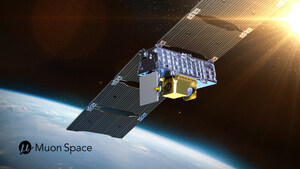Agreement establishes industry-first persistent optical connectivity in orbit, ushering in a new era of real-time satellite operations
MOUNTAIN VIEW, Calif., Oct. 21, 2025 /PRNewswire/ -- Muon Space, a leading end‑to‑end space systems provider specializing in mission‑optimized satellite constellations, today announced an agreement with SpaceX's Starlink to integrate its mini laser terminals into Muon's high-performance Halo™ satellite platform.
Starlink's mini lasers are designed to achieve link speeds of 25 Gbps at distances up to 4,000 km (and are capable of higher link speeds at shorter distances). By connecting to Starlink's global satellite network, Muon will offer customers persistent, real-time access to their satellite constellations and data on-orbit — eliminating the latency associated with traditional ground networks and enabling real‑time tasking, payload operations, and ultra-high bandwidth data streaming to anywhere on Earth. This agreement integrates Muon's satellites into Starlink's global digital infrastructure, delivering critical insights and services, and opening new business models where constellations operate with the same Internet speed and responsiveness as cloud providers and telecom networks on the ground.
"This is a sea change in how space systems operate," said Pascal Stang, CTO of Muon Space. "With persistent optical broadband, Muon Halo satellites will move from being isolated vehicles to becoming active, real‑time nodes on Starlink's global network. That shift transforms how missions are designed and how fast insights flow to decision‑makers on Earth."
"High-speed, low-latency connectivity on orbit is foundational for modern space missions," said Michael Nicolls, VP of Starlink Engineering at SpaceX. "By integrating Starlink mini lasers, Muon's spacecraft can remain persistently connected through our in-space laser mesh, enabling real-time tasking, continuous command-and-control, and immediate data delivery to terrestrial points of presence. We're excited to support Muon Space as they bring these capabilities to commercial missions."
Revolutionary Changes for LEO Satellite Constellations
Built from the ground up as fully integrated network-connected platforms, Muon's Halo satellites now extend that design globally, ushering in a new era where spacecraft operate as always-on, high-performance nodes in a worldwide data ecosystem.
From intermittent downlinks to persistent connectivity. Traditional ground station architectures provide brief contact windows; Starlink's mini lasers can be easily installed into Muon Halo spacecraft, creating near‑continuous connectivity by routing traffic through SpaceX's in‑orbit optical network to terrestrial Points of Presence (PoPs).
High throughput. Each terminal supports an optical link up to 25 Gbps (↓↑) at link distances of up to 4,000 km, with latency from orbit to the ground measured in milliseconds.
Data center–class pipelines. With persistent 25 Gbps backhaul, spacecraft can continuously stream to terrestrial Points of Presence and cloud environments while running in‑orbit edge processing, enabling near‑real‑time data fusion, AI inference, product generation, and closed‑loop tasking – turning each satellite into an extension of a distributed data center.
Resilience and uptime. A single terminal delivers high availability with brief handover interruptions ("hops") as the link transitions between relay satellites. Multi‑terminal configurations enable "make‑before‑break" handovers for >99% uptime and availability in typical LEO operations.
Security by design. User traffic traverses Starlink's satellite network in encrypted, mutually‑authenticated tunnels, with hardware‑anchored keys and customer‑controlled end‑to‑end encryption layered on top.
An Ideal Use Case: Earth Fire Alliance's FireSat Constellation
Muon-built missions like Earth Fire Alliance's FireSat constellation for wildfire detection and monitoring will be supercharged by the real-time high-bandwidth communications that Starlink provides. Incorporating mini lasers into future FireSats further enhances the global impact of this constellation on the growing wildfire and land management challenges around the world. This high-speed connectivity would cut FireSat data latency from an average of 20 minutes to near real-time. Incident commanders and first responders will receive near instant alerts of new ignitions – enabling rapid mobilization while fires are still small – and continuous updates on evolving perimeters and threatened communities throughout each fire's lifecycle.
"FireSat is already a game-changer for global wildfire response in terms of resolution, precision, and revisit," said Brian Collins, Executive Director of Earth Fire Alliance. "Starlink's optical connectivity offers the potential to further reduce our data delivery timeline, providing end users with the immediate information necessary to act while fires are at their earliest stages, ultimately preventing more large, disaster-scale fires."
"Our customers have been clear – their increasing operational needs require near real-time access to their spacecraft and payloads for tasking, compute, and data transfer," said Greg Smirin, President of Muon Space. "With Starlink's mini lasers integrated natively into Muon's flight‑proven Halo platform, we're able to turn real‑time connectivity from aspiration into practice across time-critical missions."
Deployment Timeline
Muon has begun integrating Starlink's mini laser terminals into current customer constellations and will be launching its first Starlink-enabled Halo satellite in Q1 2027.
Full‑Stack Advantage
Muon's vertically integrated Halo technology stack – including the MuSat XL (≈500 kg‑class) platform with high‑precision pointing and ample payload capacity – streamlines payload integration and leverages Starlink's optical broadband for rapid data movement and in‑space compute. Together, the stack delivers adaptable payload hosting, accelerated time‑to‑orbit, and next‑generation networking performance.
About Muon Space
Founded in 2021, Muon Space is an end-to-end space systems company that designs, builds, and operates mission-optimized satellite constellations to deliver critical data and enable real-time compute and decision-making in space. Its proprietary technology stack, Halo™, integrates advanced spacecraft platforms, robust payload integration and management, and a powerful software-defined orchestration layer to enable high-performance capabilities at unprecedented speed – from concept to orbit. With state-of-the-art production facilities in Silicon Valley and a growing track record of commercial and national security customers, Muon Space is redefining how critical Earth intelligence is delivered from space. For more information on Muon Space, visit: https://www.muonspace.com/.
About Starlink
Starlink is the world's most advanced satellite constellation in low-Earth orbit, delivering reliable high-speed, low-latency internet capable of supporting streaming, online gaming, video calls, and more. Starlink is engineered and operated by SpaceX. As the world's leading provider of launch services, and the only provider with an orbital class reusable rocket – SpaceX has deep experience with both spacecraft and on-orbit operations. Learn more at www.starlink.com and follow @Starlink on X.
SOURCE Muon Space

WANT YOUR COMPANY'S NEWS FEATURED ON PRNEWSWIRE.COM?
Newsrooms &
Influencers
Digital Media
Outlets
Journalists
Opted In






Share this article